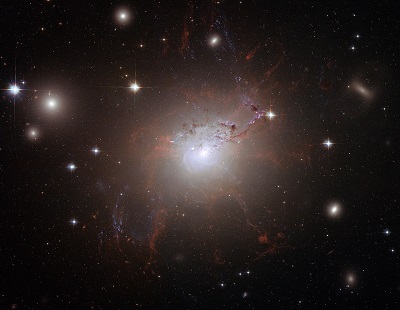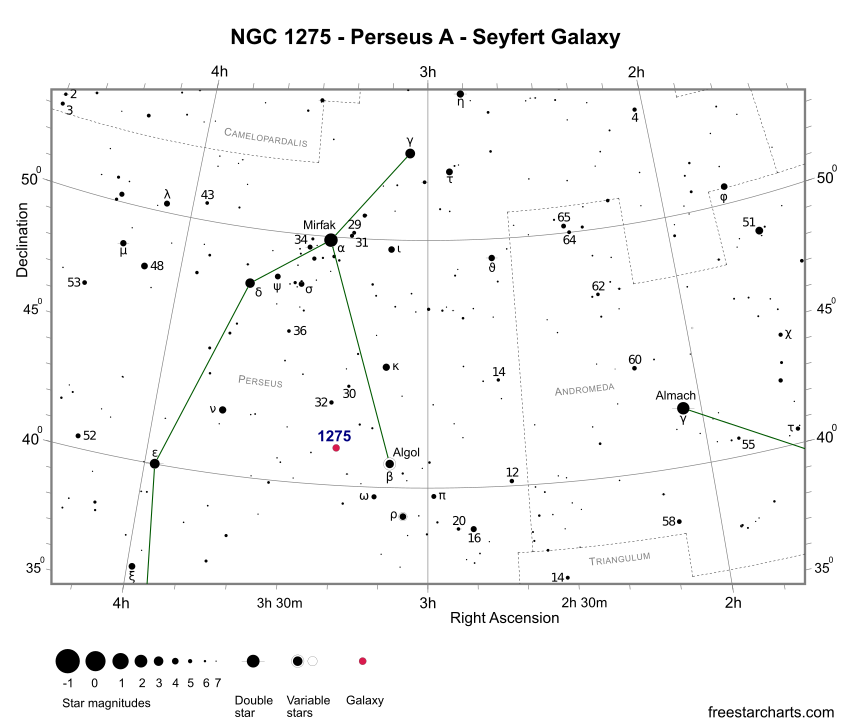NGC 1275, also known as Perseus A, is a Seyfert galaxy in the constellation Perseus. It's lies at the centre of the Perseus cluster of galaxies (Abell 426) and is the group's dominant member. At 230 million light-years distant, it's way beyond the Local Group but can be spotted in medium size backyard scopes under dark skies and good seeing conditions. This galaxy shines at apparent mag. +11.7.
NGC 1275 is a strong radio and X-ray source that produces peculiar emission lines in its nucleus. It's listed as entry 3C 84 in the 3rd Cambridge Catalogue of Radio Sources and Carl Seyfert include it in his original list of active galaxies. NGC 1275 is actually a complex system consisting of a main galaxy and a high velocity system (HVS). Tidal interactions between the two objects result in large amounts of dust disruption, gas stripping and star formation. In addition, tidal forces send existing gas and dust swirling into the supermassive black hole at centre of the main galaxy, resulting in the powerful X-ray and radio wave emissions.
NGC 1275 was discovered by William Herschel on October 17, 1786.


Finder Chart for NGC 1275 - pdf format (credit:- freestarcharts)
The galaxy is positioned towards the centre of Perseus. It's located 2 degrees east and half a degree north of famous variable star Algol (β Per). Also know as the "Demon Star", Algol is an eclipsing binary that usually shines at mag. +2.1, but every two days, 20 hours and 49 minutes it dips suddenly in brightness to mag. +3.4. It remains dim for about 10 hours, before returning to its original state.
A 200mm (8-inch) scope on a good night, shows NGC 1275 as a tiny grainy spot of weak light. Although it covers some 2.3 x 1.7 arc minutes, visually it appears much smaller at about 45 arc seconds. A 350mm (14-inch) instrument reveals a conspicuous diffuse oval shape with a bright centre. Astronomers with very large scopes can explore the Abell group in detail. Other members visible include NGC 1267, NGC 1270, NGC 1272, NGC 1273, NGC 1274, NGC 1278, NGC 1281 and IC 1907.
NGC 1275 and the Perseus cluster are best seen from northern latitudes during the months of November, December and January. It's number 24 in the Caldwell catalogue.
NGC 1275 Data Table
| NGC | 1275 |
|---|---|
| Name | Perseus A |
| Caldwell | 24 |
| Object Type | Seyfert Galaxy |
| Constellation | Perseus |
| Distance (light-years) | 230 Million |
| Apparent Mag. | +11.7 |
| RA (J2000) | 03h 19m 48s |
| DEC (J2000) | +41d 30m 42s |
| Apparent Size (arc mins) | 2.3 x 1.7 |
| Radius (light-years) | 75,000 |
| Number of Stars | 1 Trillion |
| Notable Feature | Strong source of X-ray and radio waves |